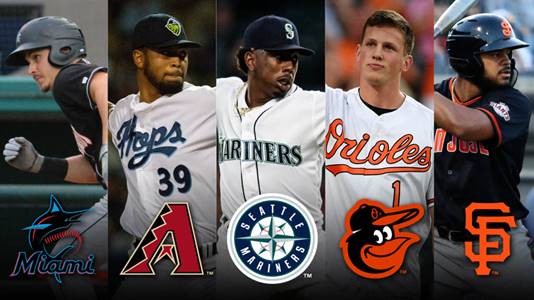By Bill Knudsen

My expectations on the 2020 Seattle Mariners season…Whether you agree with the Mariners rebuild, or not, it’s happening. So, what might we expect from our team? And the fans?
• Attendance, viewership and listening—all down. The M’s drew 22,122 fans per game last season. I think they could see a-6%-8% drop-off this year. (Unless they finally do my dream giveaway, ‘Rolex Watch Night.’ )
• From a win/loss perspective, I think, despite all the young talent, who should be fun to watch for us serious M’s fans, they could lose 85-90 games—with a lot of early inning blowouts.
The truth of the matter always has been that the Pacific NW has enough hard-core baseball fans and season ticketholders to sell 15,000-17,500 tickets. (Perhaps a few more on weekends.) Over, and above that, the opponent must be attractive, the weather must be perfect or the giveaway has to be a big deal. This is the ultimate “fair weather fan” market, wherein the average fan is thinking, “what have you done for me lately.”
And this rebuild had better work because we now have two pro football teams, an excellent and perpetually winning collegiate football team, a championship soccer franchise, an always-competitive WNBA team and, soon, a well-run NHL hockey team—none one of whom are giving their tickets away. In the immortal words of the late Al Davis… “‘ya just gotta win, baby.”
That being said, I’m anxious to see these young kids play in The Show. They are hungry… they are used to winning and their lifelong dreams are coming true right—before our eyes. And while the franchise has struggled for 43 years, these kids haven’t. They don’t know about the long-suffering fans. They just want to get a hit, turn a double play or strike someone out. There are going to be some moments of brilliance and, if you’re there, or are watching, you’re going to remember it forever.
Under Construction
The Seattle Mariners baseball team is not the only thing under construction these days. As you may know, the Mariners are spending more than $30 million this Winter making the T-Mobil Park experience even better than it has been. The biggest changes will be one’s the fans won’t see.
The painting, the air conditioning, the roof-level improvements are all things that I, as an average fan won’t notice, but they all are important in making sure we have this ballpark for another 100 years.
The franchise also will change three areas in the stadium to make them more social, including expanding access to “The Pen.”
Infrastructure Improvements—$20.56 million
The 49 capital improvements need to keep the ballpark in good working order include:
On-going replacement of roof wheels, painting, plumbing and other basic infrastructure work; replacement of the ballpark’s original, now 20-year-old, sound system; replacement of the inadequate point-of-sale system to improve the fan experience at concession stands; and ADA fan improvements.
Fan Upgrades—$9.24 million
In addition to maintaining and improving the ballpark’s infrastructure, the 25-year lease between the Mariners and the PFD requires the Mariners to continually upgrade the fan experience. The upgrade projects to be completed for the 2020 season will benefit fans on all levels of the ballpark.
2020 Required Fan-Upgrade Projects: Expand the Left Field Gate to add 15 additional points of entry for fans and replace the existing Left Field ticket office with a new concession area that will connect to The T-Mobile “Pen”; create a new bar and fan/group entertainment space at Lookout Landing above the left field foul pole on the View Level; create an elevated Rooftop Boardwalk above the Home Plate Gate rotunda with enhanced viewing areas, concessions, monitors and kids play activities; and introduce a new seating option in the First Base Terrace Club with Terrace Club Loge Boxes and Terrace Club Tables to provide an alternative to single seats in favor of small-group or social spaces for fans.
In many ways, T-Mobile Park was ahead of today’s trend toward social spaces with The T-Mobile “Pen.” Management knew that fans want to connect with friends and share their ballpark experience. The improvements at Lookout Landing, the Rooftop Boardwalk and Terrace Club will provide fans with even more open areas and flexible spaces to enhance their ballpark experience.
Five Most Improved Farm Systems
Every team takes pride in its ability to build a strong farm system and develop homegrown talent. Some are better than others at it, of course. Back in August, in the wake of the trade deadline, MLB Pipeline ranked baseball’s Top 15 farm systems.
That list doesn’t tell the whole story, though, as there were many clubs that made significant gains on the farm in 2019 by adding talent via the draft, the international market or trades.
So, as we head into the New Year, here’s a look at the five teams whose farm systems improved the most in 2019.
1. Miami Marlins
The Christian Yelich and J.T. Realmuto trades in back-to-back off-season’s helped infuse some fresh, high-ceiling talent into Miami’s system—including top prospect Sixto Sanchez, acquired in the Realmuto dea. And the club continued to add impact prospects over the course of the season via trades and the draft. The Marlins’ sneaky-good deadline deals to get Lewin Diaz (Twins), Jazz Chisholm (D-backs) and Jesus Sanchez (Rays) netted the organization three young left-handed hitters with upper-level experience, and they also drafted an impressive crop of college hittersk including JJ Bleday and Kam Misner, the Nos. 4 and 35 overall picks. Meanwhile, many players already in the system took positive steps forward in their development, including Isan Diaz, Monte Harrison, right-hander Edward Cabrera and left-handers (and former first rounders) Braxton Garrett and Trevor Rogers.
2. Arizona Diamondbacks
Arizona checks in right behind the Marlins in terms of the most-improved farm systems of 2019, and although their depth stands out more than their Top 100 Prospects at this point, it should get more balanced as young outfielders Alek Thomas, Kristian Robinson, Corbin Carroll and others continue to develop. The D-backs’ farm resurgence began with a strong 2018 Draft and continued last offseason when they dealt Paul Goldschmidt to St. Louis for Carson Kelly, Luke Weaver and prospect Andy Young. Selecting seven times within the first 75 slots in the 2019 draft enabled the club to land Carroll, as well as some of the best pitchers in the class (left-hander Blake Walston, right-handers Brennan Malone and Drey Jameson). The D-backs’ decision to trade shortstop Jazz Chisholm to the Marlins was surprising, though it did get them Zac Gallen in return, and they obviously added a lot of talent in the Zack Greinke deal at the trade deadline, bringing in three current or former Top 100 guys (Seth Beer, righties J.B. Bukauskas and Corbin Martin). Meanwhile, after a winning 2019 season, the D-backs are seemingly positioned to trade from their prospect depth to improve their big league roster.
3. Seattle Mariners
The blockbuster deal that sent Robinson Canó and Edwin Díaz to New York for former Mets first-rounders Jarred Kelenic (2018) and Justin Dunn (2016) last offseason laid the groundwork for what would be an all-around breakout year for Seattle’s farm system, which went from having zero Top 100 prospects at the outset of the season to five at season’s end. Kelenic and teen phenom Julio Rodriguez give the Mariners a pair of potential star-caliber outfielders to build around in future years, while the past two Drafts have provided the system with a pair of excellent college pitchers in Logan Gilbert (2018) and George Kirby (2019). Much of this talent has already reached the upper levels, as both 2018 draftee Cal Raleigh and trade acquisition Jake Fraley turned in very solid 2019 seasons, while 2016 first-rounder Evan White appears ticketed for the big leagues in early 2020, after signing an offseason extension. Lefty Justus Sheffield and outfielder Kyle Lewis (two more former first-round picks) seem poised for larger roles next season, underscoring the quality of Seattle’s prospect depth. Relievers Taylor Guilbeau and Aaron Fletcher should carve out bullpen roles after joining the organization via deadline deals.
4. Baltimore Orioles
The system has already come a long way since Mike Elias took over as Orioles general manager after the 2018 season. In that short span, the Orioles have gone from having a bottom-third system to one of the 15 best in baseball. Any time a team can add a generational-type talent, like 2019 No. 1 overall pick Adley Rutschman, it’s going to accelerate the rebuilding process. The 2019 Draft also netted Top 15 prospects Gunnar Henderson and Kyle Stowers. All of their Top 100 guys (Rutschman, Grayson Rodriguez, DL Hall and Ryan Mountcastle) are former first-round picks, and they all made respective developmental strides last season. The club already acquired four pitching prospects, including a trio of Top 10-round 2019 picks, this offseason from the Angels in the Dylan Bundy trade. And the organization’s commitment to the international market also should yield dividends in the future.
5. San Francisco Giants
While the Giants didn’t crack MLB Pipeline’s list of the Top 15 farm systems in August, they still had one of the most improved systems in 2019 and finished the year with four Top 100 prospects—more than they’ve had since MLB.com bega ranking prospects. Much of that success is tied to San Francisco’s recent international efforts, which have netted the organization Marco Luciano and Alexander Canario, as well as a host of other young hitters. Former first-round picks Joey Bart (2018) and Heliot Ramos (2017) both advanced to Double-A together, and it might not be long until they’re joined by 2019 first-rounder Hunter Bishop. And with an impressive crop of rising hitters in place, it now will be up to the Giants to develop pitchers capable of furthering the team’s resurgence in 2020 and beyond.








